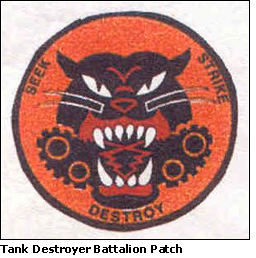|
Introduction
 This dramatic story is being recorded on our Website as part of the history of 89th Infantry Division. At the request of your co-webmaster, Dr. Raymond J. Young, who served with Company A Headquarters platoon as 50 cal. machine gunner on the Commanders vehicle and later as leader of the Recon Section, has provided the following material which had been extracted from original stories in 602nd newsletters and other sources, including his own. We are also indebted to Drew Baltuskonis for some of the photos provided, originally taken by Phillip J. Bonelli, Company C, now deceased.
This dramatic story is being recorded on our Website as part of the history of 89th Infantry Division. At the request of your co-webmaster, Dr. Raymond J. Young, who served with Company A Headquarters platoon as 50 cal. machine gunner on the Commanders vehicle and later as leader of the Recon Section, has provided the following material which had been extracted from original stories in 602nd newsletters and other sources, including his own. We are also indebted to Drew Baltuskonis for some of the photos provided, originally taken by Phillip J. Bonelli, Company C, now deceased.
The 602nd Tank Destroyer Battalion was originally formed 26 March 1941 as the 2nd Infantry Division Provisional Anti-Tank Battalion. Peter J. Kopcsak, all American football end in 1931 and 1933 and Division Artillery G-3 became the Executive Officer. On 15 December 1941, the unit became one of the first four designated as a Tank destroyer Battalion, and Col. Kopcsak became its commander. In 1942, after about two months of Louisiana maneuvers, the Battalion moved out for specialized training as one of the first to occupy facilities at Camp Hood, Texas. The Commander, Peter Kopcsak, had written the original T.D. tactics for the school. During WWII, the Battalion was attached and detached to 28 different Infantry, Armored and Airborne Divisions, Corps, Groups, and Task Forces, and often one or more companies or parts of companies were attached to some other unit. The Battalion was the first of General Patton's 3rd Army to reach the vicinity of Bastogne on 21 December 1944. As part of a Task Force commanded by Col. Kopscak the 761st Tank Battalion, an all black unit, saw its first combat. Later, men of the 602nd attached to the 89th Infantry Division and the 4th Armored Division, were the first on April 1945 to enter the first death camp liberated by the Western Allies at Ohrdruf, Germany. During the Battle of the Bulge, Company C was awarded a Presidential Citation for its role in eliminating the Harlange Pocket. Our gratitude is extended to Professor Young and his comrades for permitting us to include this history on our Website and making it available to scholars, historians and others worldwide. We are proud of having been associated with you.
HISTORY OF THE 602nd TANK DESTROYER BATTALION
(While Attached to the 89th Infantry Division in World War ll)
This section was prepared from copies of morning reports found in the National Personnel Records Office of the Department of Veterans Affairs in St. Louis, a Battalion Journal based on after action reports and other documents written in early May, 1945, a Company A Journal which was kept in note form and written the week the war ended in early May, 1945, including parts of two diaries kept by two men, one of which was KIA during the Battle of the Bulge. The author of this section and one of the authors of the Company A Journal was Dr. Raymond J. Young, Historian, and 602nd Tank Destroyer Battalion Association, Inc.
On 12 March 1945, elements of the 602nd Tank Destroyer Battalion from widely scattered locations and assignments in Easter Belgium, Western Germany, and Northeastern Luxembourg converged and closed by 1730 hours on an area containing several villages in vicinity of Bitburg, Germany. The Battalion, all together for the first time since 27 November 1944, was attached to the 89th Infantry Division. Companies A and B, respectively, were attached to the 353rd and 354th Infantry Regiments. The 1st and 2nd platoons of Reconnaissance Company, respectively, were assigned to Companies A and B. Villages occupied by the 602nd were Dudeldorf, Gindorf, Erdorf, and Picklesseim. On the 13th, Company A moved with the 353rd Regiment to Bad Bertrich and met with little resistance. The rest of the 602nd TD Battalion moved to Immerath, except Company B with its Recon platoon attached moved to Driesch where it stayed until the 17th. On the 13 Company C was assigned to the 354th Infantry Regiment, and plans were made for crossing the Mosel River. Company C was at Immerath until the 11h. On the 13th Company C lost a non-battle casualty shot in the foot, and on the 14th a non-battle casualty was lost also. On the 14th Ellsworth Holton was slightly wounded in action by fragments of an exploding enemy mine.
|

